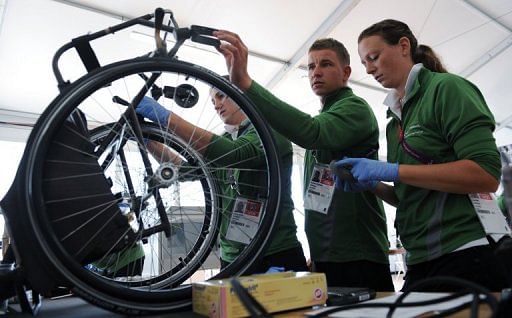
Workshop knocks wheelchairs, limbs into shape
LONDON (AFP) –
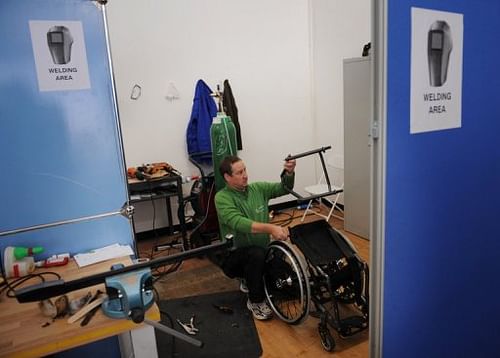
A technician works on a wheelchair belonging to an athlete competing in the London 2012 Paralympic Games at the at the wheelchair orthotic and prosthetic repair centre in the Athletes Village in east London.
Between the din of drilling and banging and the anxious faces of athletes in its waiting room, the Paralympic repairs workshop feels like a cross between a doctor’s surgery and a mechanic’s garage.
An industrial smell of molten plastic and metal fills the air at the workshop, which has carried out some 200 repairs every day at the athletes’ village in east London since the Games began a week ago.
“The most repairs are for athletics, simply because that has the biggest number of competitors,” said Peter Franzel, the workshop’s organising director.
“But the most damage is definitely done in wheelchair rugby and wheelchair basketball. These sports are just brutal. We do a lot of welding.”
The 80-strong staff at the centre, run by German prosthetics firm Ottobock, includes technicians specialising in wheelchair repairs, prosthetic limbs and orthoses — devices that support the athletes’ bodies.
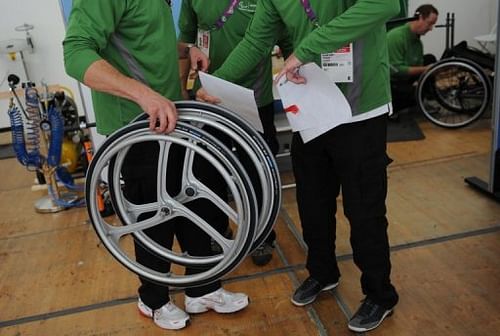
Technicians at the wheelchair orthotic and prosthetic repair centre carry out repairs on wheelchairs belonging to athletes competing in the London 2012 Paralympic Games at the Athletes Village in east London.
The shelves are stocked with some 15,000 spare parts, including limbs, tyres, running blades like those worn by South African double-amputee sprinter Oscar Pistorius and thousands of screws, nuts and bolts.
In one corner, Cape Verde’s only competitor in the Games — T44 100m, 200m runner and F44 javelin thrower Marcio Miguel Da Costa Fernandes — watches anxiously as the technicians fix a socket to his running blade.
“Normally the athletes stay in the waiting area, but if they want to have a look they can,” said Franzel. “He (Fernandes) is racing tonight (Wednesday), so naturally he wants to see what we’re doing with it.”
But rather than the specialist kit that takes a bashing when athletes compete, the majority of repairs are on their everyday wheelchairs and other equipment.
“The wheelchairs that athletes use every day actually get more worn out than the ones they use for sport, which they might use for just one or two hours every day,” Franzel explained.
All repairs and replacements are completely free of charge — prompting regular accusations that disabled athletes from developing countries exploit the Paralympics as a chance to get free equipment.
In one storeroom, two battered old wheelchairs sat destined for the rubbish dump after Ottobock gave new ones to their owners, a Nepalese Paralympic official and an Egyptian athlete.
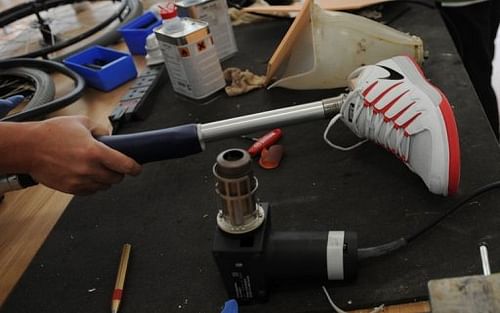
A technician works on a prosthetic leg at a repair centre for prosthetics and wheelchairs belonging to athletes competing in the London 2012 Paralympic Games at the Athletes Village in east London.
Ottobock spokeswoman Anna Parisi said while there was a clear discrepancy in the quality of kit used by richer and poorer Paralympic teams, there were few cases of poor athletes asking for new equipment.
“We do experience athletes coming from developing nations with products that are very old,” she told AFP.
“But quite often they were very happy with what they were using. And when there’s a problem with them, because they are so old it’s often easier for us to replace rather than repair.”
The most frequent visitors to the workshop were members of the United States, Brazilian and Colombian squads, Parisi said.
Franzel added it was hugely rewarding to see the look on someone’s face when they were handed equipment that would vastly improve their mobility.
“They’re really, really happy. It’s like someone giving you a brand new Mercedes,” he said.
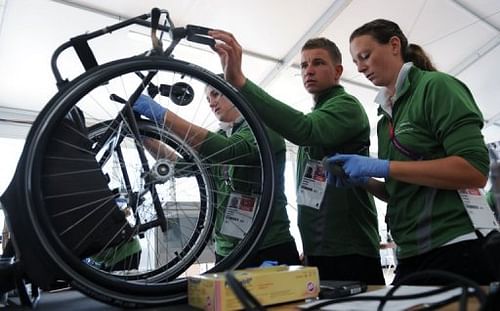
Technicians at the wheelchair orthotic and prosthetic repair centre carry out repairs on wheelchairs belonging to athletes competing in the London 2012 Paralympic Games at the Athletes Village in east London.
As every athlete’s equipment is customised to their particular needs, he added, the technicians had to be “very inventive”.
“Sometimes the first technician who sees a repair will have no idea how to fix it, then three or four of them will work together and find a solution.
“We have a lot of spare parts here but not everything. If we’re missing something we send someone to a hardware store. And if we can’t get it there, we’ll try to make it ourselves with a little welding.”
Most of the workshop’s tasks consist of mundane repairs, some 80 percent of them to wheelchairs. But occasionally, the technicians are greeted with more obscure demands.
“The weirdest request was one team that showed up with a paper shredder that wasn’t working,” Franzel recalled.
“Of course, we’ll only do that kind of thing when it’s quiet. We wouldn’t let our athletes sit in the waiting area while we fix a shredder.”
At a sewing machine, prosthetics expert Donna Fisher sat sewing up a hole in a Canadian athlete’s backpack.
“If they bring it, we’ll try to fix it,” she said cheerfully.